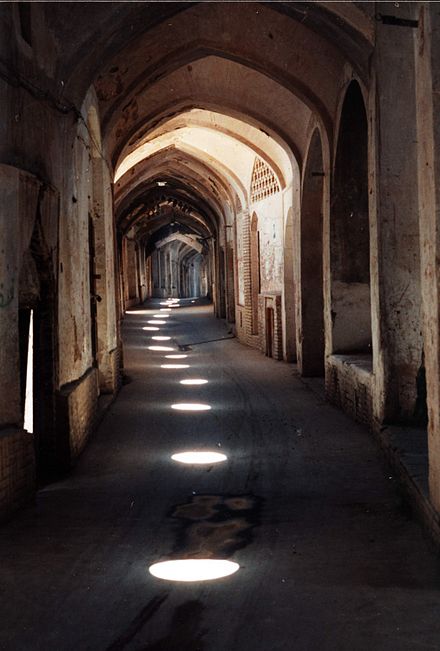Na'in - county in Isfahan Province, Iran
Na'in (also known as Naein and Naeen) is a pre-Islamic town, more than 2,000 years old, on the edge of the Central Desert of Iran in the Isfahan province of Central Iran. It is known for extremely fine carpets.
Understand
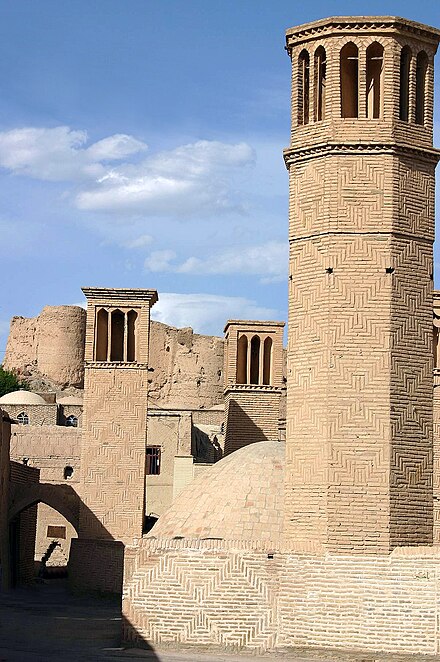
With an area of almost 35,000 km<sup>2</sup>, Na’in lies at an altitude of 1545 m above sea level. Like much of the Iranian plateau, it has a desert climate, with a maximum temperature of about 41°C in summer, and minimums of -9°C or so in winter.
More than 3,000 years ago the Persians learned how to construct aqueducts underground (qanat or kariz) to bring water from the mountains to the plains. In the 1960s this ancient system provided more than 70 per cent of the water used in Iran and Na’in is one of the best places in all the world to see these qanats working as they were intended.
Unique to Na’in are some of the most outstanding monuments in all of Iran: the Jame Mosque, one of the first four mosques built in Iran after the Arab invasion; the Pre-Islamic Narej Fortress; a Pirnia traditional house; the Old Bazaar; Rigareh, a qanat-based watermill; and a Zurkhaneh (a place for traditional sport).
Besides its magnificent monuments, Na’in is also famous for high-quality carpets and wool textiles.
Some linguists believe the word Na’in may have been derived from the name of one of the descendants of the prophet Noah, who was called "Naen". Many local people speak an ancient Pahlavi Sasani dialect, the same dialect that is spoken by the Zoroastrians in Yazd today. Other linguists state that the word Na’in is derived from the word "Nei" (“straw” in English) which is a marshy plant.
Get in
From Isfahan, travellers can use the Jay terminal and take the Na'in bus or mini bus (100,000 rials). An alternative is the Isfahan-Yazd bus, which leaves the terminal once every hour, if they inform the driver that Na'in is their final destination and the fare is 80,000 rials.
From Yazd, travellers can take the Yazd - Isfahan buses from Yazd terminal and ask the driver to stop in Na'in which costs 150,000 rials.
From Tehran, there are two terminals available: Jonub terminal, with buses leaving at 10:00 and 17:00; Beihaghi (Arjantin) Terminal, with one bus departing at 23:00. The ticket price is 260,000 rials.
In Na'in, there are regular buses to Isfahan departing on average every round hour, from the only bus station 📍 in town. Private taxis are available 24 hours a day at the Isfahan roundabout 📍 ("Falake Esfahan"). Departing the town to Yazd is possible by waiting for the buses to Yazd at the "Falake Esfahan" or by taking a taxi to the Yazd Road police station.
Get around
The old town is quite small and walkable. For destinations like Mohammadieh neighbourhood or bus station there are plenty of taxis plying the streets, both rides cost 50,000 rials (as of 2017).
See

- Jame Mosque, 32.869°, 53.088°. Tu-Su 08:00-21:00 in summer, or 08:00-18:00 in winter. The construction of Jame Mosque dates back to the 8th century CE, but the whole of the complex has been constructed in stages. The stucco around the Mihrab (niche) belongs to Ale'Buye in the 11th century. The yard was constructed in the time of the Siljuks (12th century), and the basement is believed to be pre-Islamic and later became part of the mosque, one of the oldest in Iran. Its magnificent plasterwork over the niche, the marvellous brickwork around the yard, and its silent basement--which may have been used as a fire temple before the mosque was built here—are only a few of its features. This mosque has no Iwan and dome as do the other famous mosques in Isfahan and Yazd. A 28 m tall octagonal minaret was added almost 700 years ago. If you stand in the middle of the yard, you will find yourself surrounded by 14 columns, each one adorned with a unique and intricate pattern of brickwork. The alabaster stonework reflects sunlight throughout the basement. An underground water channel runs underneath the mosque. There is a stairway that connects the mosque to the water channel and to chambers above the pool. 100,000 rials 2017-03-06
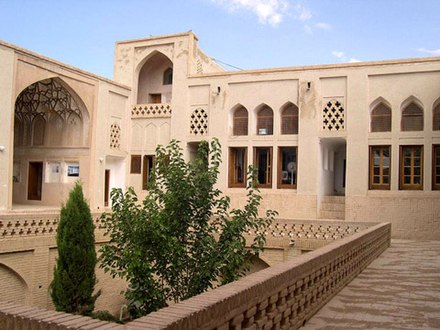
- Pirnia traditional house and ethnology museum, 32.86829°, 53.08778°. Tu-Su 08:00-21:00 in summer and 08:00-17:30 in winter. A perfect example of this region's desert houses, in terms of architecture and art, constructed in the Safavid Period. The house consists of an exterior, an interior, a deep garden, a silo room and all of the facilities that a lord’s house needed to have at the time it was constructed. When you enter the house and pass the first corridor, you reach an octagonal room called “hashti”, which used to be a waiting room for clients and visitors. Beautiful paintings, amazing plasterwork of Qur’anic stories, a book of famous poems and exquisite calligraphy decorate the living room. First, a judge of Na'in lived there. Then, during the Qajar Period, the house belonged to a governor of Na'in. Just a few decades ago, the house was purchased by the Ministry of Culture and Art. After renovation in 1994, the house was converted into the desert ethnology museum. 100,000 rials 2017-03-06

- Mosallah edifice, 32.86022°, 53.09093°. 08:00-12:00, 15:00-17:00. Another remarkable monument to see in Na'in. Its vast garden used to be a popular recreational area until a few years ago. The mausoleum inside the Mosallah was a pilgrimage site for visitors. The dome of the Mosallah is opposite the dome of the shrine of Emamzadeh Sultan Seyyed Ali; these two are connected by a street. There is a water reservoir on one side of the garden, which can be accessed through a stairway on its side. Water in this reservoir was cooled by two wind towers. The water reservoir (Persian: ab-anbar) was in use until a few years ago. The architectural style of Mosallah is characteristic of the Qajar dynasty, and a number of literary, political and religious figures are buried at this site. “Mosallah” is an Arabic word for a place of prayer but, no one knows if any praying was ever done at this location. The Mosallah is an octagonal mausoleum of dervishes and Qajar and Pahlavi political figures. It's encompassed by a military fort from the Qajar era, with a high wall, thick enough for a horse to be ridden along the top. The pistachio trees around the turquoise-domed mausoleum and two tall wind towers make the complex very photogenic. 2017-03-06
- Emamzadeh Sultan Seyyed Ali Complex, 32.8643°, 53.0954°. Mausoleum of Emamzadeh Sultan Seyyed Ali. Free admission 2017-03-26
- Castle of Narenj, 32.8673°, 53.08946°. Also known as Narin castle. The construction materials used in the castle and its style of architecture hint that it was built in the pre-Islamic era. According to surveys and other evidence, this monument might belong to the Partiyan period. Its exact use is not known. However, it is thought to have been part of the military and official compounds of the city. Many researchers of the Safavid era have spoken of numerous castles known as Narikh Qalae, which were used for military purposes. Hence, it can be concluded that Na'in's Narikh Qalae was also a military establishment. The famous historian and researcher, Estakhri mentioned there was a moat with a 900 m perimeter dug around the castle. 2017-03-06
- Bazaar, 32.86527°, 53.0933°. Remarkable historical attraction. The bazaar extends 340 m in a curved line from the Gate of Chehel Dokhtaran to the mosque of Khajeh Khezr, and is connected by main alleys, as well as by tributary passages, to various neighbourhood centres. The bazaar has two main crossroads or chahar su. Parts of it have been renovated, and its many varied stalls were active until a few years ago. However, nowadays the bazaar has been almost deserted, since the retailers moved to the city's street shops. Some important monuments, such as the mosque of Sheikh Maghrebi, the mosque of Khajeh, and the Hosseinieh of Chehel Dokhtaran, are very near. 2017-03-06
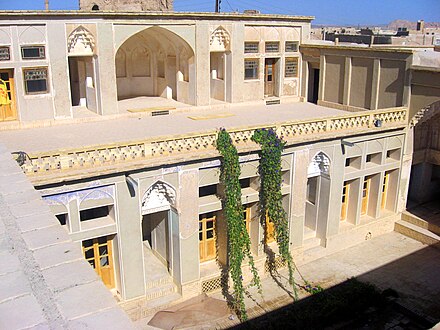
- Fatemi House, 32.86699°, 53.09022°. Grandest traditional house in Na'in. It's in front of Narenj Castle, beside the old bazaar. The house belonged to a very influential family in Na'in. It consists of a large number of sections, each one with a different function: winter living rooms, summer living rooms, stable, resting rooms, silos, corridors, dining rooms for guests, and other facilities. Most of the rooms are furnished with stained glass windows, inlaid wooden doors, and plasterwork. The house is now the property of a cultural heritage organization. 2015-11-06
Mohammadieh village
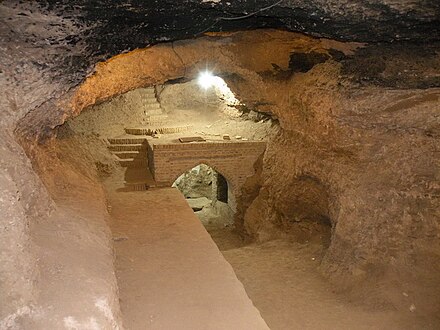
 Mohammadieh — village adjacent to Na'in in about 3 km east of it.
Mohammadieh — village adjacent to Na'in in about 3 km east of it.
- Rigareh watermill, 32.86352°, 53.114°, +98 939 863 6090. Open to public only in Noruz (the Persian New Year holiday). Visits at other times of year can be arranged by local guides. A qanat-based water mill. The age of this engineering masterpiece is unknown; however, some historians believe that it dates back to the pre-Islamic era. The water is supplied by the Keykhosrow qanat channel, and the mill is placed almost 28 m underground. The access corridor to the mill is about 133 m long. A qanat channel crosses 9 m above the mill and fills the huge 9 m. height water tank. When enough pressure is provided, the water is released and rotates the turbine. The waste water flows out along the channel and joins the main qanat channel with a gradual slope 15 m further down. This is the only place in the country where visitors can get inside a living flowing qanat with 19 m depth, accessible through a 12 m corridor. Since the advent of electricity to grind the wheat and barley, this water mill has become a part of history. 2017-03-06
- Mosque of Mohammadieh, 32.86472°, 53.11161°. Built in the late 10th/early 11th century AD. The altar of the mosque, and the ceilings on the two sides of its nocturnal prayer hall or Shabestan, resemble the Jameh Mosque of Na'in. The village also houses the beautiful Jameh and Sar Kuche mMosques, a fortress, the ancient Rigareh watermill and the cloak workshops. 2017-03-06
- Aba Bafi Man-made Caves, 32.86667°, 53.11125°. Open from dawn to dusk, with a short break 12:00 - 13:30. In Muhammadieh, a precinct of Na'in, there are some man-made caves. Locals call them sardab and aba bafi. Evidence shows that they were dug by the Zoroastrian inhabitants who used to live there because the cave entrances open to the east, where the sun rises. After they were abandoned by the Zoroastrians, Muslim inhabitants used them as loom workshops to weave cloaks and rugs, from two types of sheep and camel wools. Weaving cloaks by hand is one of the most valuable handicrafts and historical arts of Na'in. Some of the workshops are 700 years old. Free 2017-03-06
- Mohhamadieh citadel, 32.8713°, 53.1157°. Ancient fort over the hill, 150 m away from the caves, with a small entrance at the back. There visitors can enjoy a beautiful perspective of the village and the desert around it. Free admission 2017-03-26
Do
- Desert trekking and camping is one of the possibilities for sightseers in this desert town, since a desert with moving sand dunes surrounds Na'in. It's desert trekking on real moving sand dunes, since there are sand hills from 5 to 62 m high that are always moving when the wind blows - the highest sand dunes in Iran. Also sleeping (camping) on the moving sands and having dinner and breakfast there is possible through the local tour agents. There is no regular desert transport, so a private taxi or car should be rented.
- Mountaineering: There are some desert-type mountains west and north east of Na'in. The one to the north east (as you see in the middle and lower photo) is worth a visit. There are some unpaved roads that lead there. A downhill bicycle is recommended, but use of a tour guide is advised. Also there is a walking tour called survival tour available in the mountainous area in distances of 5 km, 10 km and 15 km.
- Cycling: Bicycle rentals are available through some of the tour agents.
- Zurkhaneh, 32.86198°, 53.08301°. It starts around 18:00-19:00. Zurkhaneh, Zorkhana or Zourkhaneh (in Persian/Kurdish: زورخانه, literally "house of strength") is a sport with thousands of years of history, incorporating the values of strength, joy of effort, generosity, chivalry, love of country, of art and literature. It has played a great role in empowering the mental and physical health aspects of the Iranian people. There are 3 Zurkhaneh in Na'in, but the Valiye Asr Zurkhaneh, located in Valiye Asr Street, is perhaps the most suitable to visit. Unlike Yazd and Isfahan where tourists need to pay for admission, it's free here 2017-03-06
- Naintours, inside of Na'in Jame mosque's Babolmasjid complex, 32.86861°, 53.08824°, +98 939 8636090, naintours@yahoo.com. Offers desert trekking, camping and mountaineering tours. Transportation, food, tents and sleeping bags are included for the relevant trips. Also rents out bicycles. 2016-12-03
Buy
There are number of banks where one can exchange currency for the official rate, otherwise use commercial exchange office with rates 10-15% higher than the official one.
- Exchange office, 32.8626°, 53.0939°. Exchange rate is similar to the better ones offered in Tehran so it's quite a good deal. 2017-03-26
A fine art of weaving carpets began in Na'in about the time of World War II. Because carpet weavers from Na'in worked with thinner wools, they began to weave rugs of much higher quality. Since the number of carpets produced was low and the quality of carpets was exceptionally high, the weavers found a profitable market. Carpet-weaving in Na'in has a history of using non-Iranian wools and of using local, traditional designs with unique colouring, thus drawing the attention of the world market. Na'in style carpet is woven in different places in Iran - but the quality will be very different in each place. One reason that carpet actually woven in Na'in is so popular, is that it uses predominantly natural and traditional colours rather than synthetic dyes. Other reasons include the sheer quality of the weft obtained from using mainly wooden looms. This all means that Na'in can easily claim that it is one of the best producers of hand woven carpets in all Iran. Woolen textiles are also available in Muhammadieh, where you can buy the handicrafts directly from the producers.
Eat
There are a bunch of fast food cafes (at least 8-9 of them) on the Imam Khomeini street between Jahangardi Hotel and Gholami Guest House. Jahangardi Hotel and Gole Narges Hotel have restaurants.
- Golchin Restaurant (گلچين), Motahhari Blvd., 32.865425°, 53.075835°, +98 31 4626 6400. 10:00–22:00. It has some typical but high-quality Persian food, with good service. 2017-03-26
- Laleh Sahra (رستوران لاله صحرا), Motahhari Blvd., 32.864684°, 53.079030°, +98 31 4629 1201. 12:00-21:00. 2017-03-26
- Hani هانی Restaurant. It is the place to have traditional “abgusht” or "stew". 2017-03-26
- Cafe, 32.86315°, 53.08292°. A small shop in front of Laleh Park serves “del'o jigar” (chicken's heart and liver). You can have a delicious meal for just US$3. 2017-03-26
- Kavir Restaurant, Sh Rajaei Ave, 32.86027°, 53.08200°, +98 31 4625 3799. 24 hours. Decent restaurant at the underground floor with some traditional dishes. 2017-03-26
Drink
Doogh (دوغ) is a sour drink made from yoghurt, salt, and water; sometimes carbonated and sometimes flavoured with mint or other plants. It is an acquired taste but will rehydrate you quickly in the heat of Iran's summer. It is the same as Turkish ayran.
Sleep
Rooms at all four hotels can be booked in advance and at a discount, depending on the season.
Budget
- Emamzadeh Zaer sara Guest House, Emamzadeh Soltan Seyed Ali complex, 32.8645°, 53.0961°, +98 913 9230520. Check-in: 14:00, check-out: 10:00. Traditional style. It's a pilgrim house, so dress modestly. Mattress and pillow, shared toilet. Up to 4 persons can share one room. 350,000 rial, bigger room for 400,000 rial 2017-02-17
- Gholami Guest House, 32.86298°, 53.08823°, +98 913 223 4667. It's a three-story building with a café on the ground floor. Staff speaks basic English. Single room 400,000 rials, shared toilet. Double room 730,000 rials with private bathroom. Triple room 800,000 rials, shared toilet. 4-bed room 1,200,000 rials with private bathroom 2017-03-06
- Camping, 32.8690°, 53.0890°. There is a free, quiet, secure place for camping for those who like to stay outdoors. It is popular among cyclists, motorcyclists and backpackers. It's in the historical complex of Babol Masjid, where the Jameh Mosque is located. The camping area is the open part of Hussainieh. The public rest room is always open. The locals are very friendly and helpful. The Hussainieh is off-limits only during religious ceremonies. Free 2017-02-17
Mid-range
- Nain Tourist Inn (Jahangardi Hotel), Sh Rajaei Ave (south of Imam Square, toward Isfahan Road), 32.86132°, 53.08272°, +98 314 625-3088. The government-run, excellent hotel that can accommodate both budget and mid-range travellers. It has stylish, split-level, apartment-style rooms. US$40 2017-02-17
- Gole Narges Hotel, 32.8657°, 53.0688°, +98 31 4625 0830. It has 28 rooms and a restaurant. And is located out of town so taxi could be required to get there. 2017-03-24
Cope
- Laundry, Pirnia st, 32.86166°, 53.08995°. 2017-03-26
Go next
- Isfahan — former capital with stunning architecture, great bazaar, and tree-lined boulevards. Most popular tourist destination in the country. There's a Persian saying, "Isfahan is half the world."
- Yazd — a remote desert city – circumstance influenced special architectural themes where water streams run in underground rooms in houses and wind-towers to keep them cool.
Nain County
Date Time:Please wait...Timezone:Asia/TehranPopulation:39,261Coordinates:32.86, 53.09
Isfahan Province
Primary administrative division

